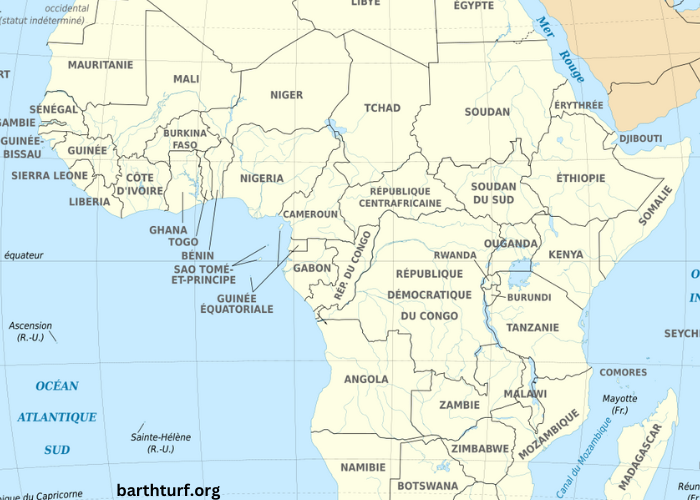Africa, the second-largest continent, is a vibrant mosaic of cultures, languages, landscapes, and histories. Its diverse regions offer a wealth of experiences that attract travelers from around the globe. A well-crafted Carte DE L’Afrique serves not just as a map but as a gateway to understanding this magnificent continent. In this article, we will explore the significance of this cartographic representation, delve into the diverse regions of Africa, and uncover the rich tapestry of cultures and landscapes that make Africa a unique destination.
The Importance of a Comprehensive Map
A Carte DE L’Afrique goes beyond geographical boundaries; it encapsulates the essence of the continent. For travelers, a map is an essential tool that helps navigate the vast expanses of Africa. However, a great map does more than show locations; it offers insights into regional characteristics, cultural landmarks, and natural wonders.
Understanding the lay of the land is crucial for anyone looking to explore Africa, whether you are an intrepid adventurer or a casual tourist. The map highlights important cities, natural parks, historical sites, and travel routes, providing a framework for planning unforgettable journeys.
Africa’s Diverse Regions
Africa is home to 54 countries, each with its own unique identity, landscapes, and cultures. Understanding the distinct regions of Africa is essential to appreciating its diversity. The continent can be broadly divided into several regions: North Africa, Sub-Saharan Africa, East Africa, West Africa, Central Africa, and Southern Africa. Each region boasts its own set of attractions and cultural significance.
North Africa
North Africa is characterized by its Mediterranean coastline, vast deserts, and rich history. Countries such as Morocco, Algeria, Tunisia, Libya, and Egypt are renowned for their ancient civilizations, stunning architecture, and vibrant markets. The Pyramids of Giza, the souks of Marrakech, and the beaches of the Mediterranean draw millions of visitors each year.
The Sahara Desert, one of the world’s largest deserts, spans much of North Africa and offers breathtaking landscapes. Adventure seekers can embark on camel treks, explore oases, and experience the traditional nomadic lifestyles that have thrived in this harsh environment for centuries.
Sub-Saharan Africa
Sub-Saharan Africa is known for its incredible biodiversity and varied ecosystems. This region encompasses diverse environments, from tropical rainforests to savannahs and deserts. Countries like Kenya, Tanzania, Uganda, and South Africa are famous for their wildlife and natural beauty.
The Serengeti National Park and the Ngorongoro Crater in Tanzania are two of the most iconic wildlife destinations in the world. Visitors flock to witness the Great Migration, where millions of wildebeest and zebras traverse the plains in search of greener pastures. Similarly, South Africa’s Kruger National Park offers thrilling safari experiences, where travelers can spot the Big Five: lions, leopards, elephants, rhinos, and buffalo.
East Africa
East Africa is a region that boasts rich cultural diversity and stunning natural landscapes. Countries such as Kenya, Tanzania, Ethiopia, and Rwanda offer a blend of vibrant cultures, breathtaking mountains, and picturesque coastlines. Mount Kilimanjaro, Africa’s highest peak, is a popular destination for climbers and adventurers seeking to reach its summit.
The East African coast, particularly in places like Zanzibar, is renowned for its beautiful beaches and rich cultural heritage. Here, visitors can explore historic stone towns, spice plantations, and vibrant local markets, immersing themselves in the unique blend of Arab, African, and Indian influences.
West Africa
West Africa is a region steeped in history and cultural richness. Countries like Nigeria, Ghana, Senegal, and Ivory Coast are known for their vibrant music, art, and festivals. The region’s historical significance is highlighted by sites like the slave forts along the coast and the ancient city of Timbuktu in Mali.
West Africa is also a culinary paradise, with a diverse array of flavors and dishes. Jollof rice, fufu, and egusi soup are just a few examples of the delicious cuisine that travelers can enjoy. Each country has its unique culinary traditions, offering an opportunity to explore the region’s diverse food culture.
Central Africa
Central Africa is often less traveled but is home to some of the continent’s most incredible natural wonders. The Congo Basin, the second-largest rainforest in the world, is a haven for biodiversity and home to many endangered species, including the mountain gorilla. Countries like the Democratic Republic of the Congo and Gabon offer unique opportunities for eco-tourism and wildlife experiences.
The region is also rich in cultural diversity, with numerous ethnic groups and languages. Travelers can engage with local communities, learn about traditional practices, and experience the region’s vibrant art and music.
Southern Africa
Southern Africa is known for its stunning landscapes, ranging from deserts to lush vineyards and dramatic coastlines. South Africa, Namibia, Botswana, Zimbabwe, and Zambia are just a few of the countries that draw visitors with their diverse offerings.
The Cape Winelands in South Africa are famous for their world-class wines, while the Okavango Delta in Botswana is a UNESCO World Heritage site known for its exceptional wildlife and unique ecosystem. Victoria Falls, located on the border of Zimbabwe and Zambia, is one of the largest and most spectacular waterfalls in the world, attracting adventure seekers and nature lovers alike.
Cultural Diversity and Heritage
Africa’s cultural diversity is one of its most compelling attributes. With over 3,000 ethnic groups and more than 2,000 languages spoken, the continent is a rich tapestry of traditions, beliefs, and customs. Each region boasts its unique cultural practices, arts, music, and festivals.
Music and dance play a central role in African culture, serving as a means of storytelling and community bonding. From the rhythms of West African drumming to the melodic sounds of East African folk music, these art forms reflect the rich heritage of the continent. Festivals such as the Fes Festival of World Sacred Music in Morocco and the Harare International Festival of the Arts in Zimbabwe showcase the vibrant cultural scene across Africa.
Art is another essential aspect of African culture, with traditional crafts such as beadwork, pottery, and weaving representing the creativity and craftsmanship of various communities. Contemporary African artists are also gaining international recognition, contributing to a dynamic and evolving art scene that celebrates both tradition and innovation.
Nature and Wildlife Conservation
Africa is home to some of the most breathtaking natural landscapes and wildlife on the planet. The continent’s commitment to conservation is crucial in preserving its rich biodiversity for future generations. Numerous national parks and reserves have been established to protect endangered species and their habitats.
Organizations and initiatives focused on wildlife conservation are vital in combating poaching and habitat loss. Eco-tourism plays a significant role in this effort, allowing travelers to experience the continent’s natural wonders while contributing to conservation efforts. Sustainable tourism practices ensure that local communities benefit from tourism revenue, fostering a sense of stewardship for the environment.
Travel Tips and Practical Information
For those planning to explore Africa, having a reliable Carte DE L’Afrique is essential for navigating the diverse landscapes and cultures. Researching specific countries, understanding visa requirements, and staying informed about health and safety precautions will enhance your travel experience.
Travelers should also consider the best time to visit, as Africa’s climate varies greatly by region. The dry season is often ideal for wildlife viewing, while the wet season can bring lush landscapes and fewer crowds.
Engaging with local guides and communities can enrich your journey, offering insights into the culture and history of the places you visit. Learning a few basic phrases in local languages can also go a long way in fostering connections and showing respect for the diverse cultures you encounter.
Conclusion
Carte DE L’Afrique serves as more than just a map; it is a portal to exploring the richness and diversity of a continent that captivates the imagination. From the stunning landscapes and vibrant cultures to the incredible wildlife and historical significance, Africa offers a plethora of experiences that await discovery.
Whether you seek adventure in the wild, cultural immersion in bustling cities, or relaxation on pristine beaches, Africa has something for every traveler. By utilizing a comprehensive map and understanding the unique regions and cultures, you can embark on a journey that promises to be as enriching as it is unforgettable.
As you explore the diverse tapestry of Africa, let the Carte DE L’Afrique guide you through this magnificent continent, opening doors to experiences that will leave lasting memories and a deeper appreciation for its beauty and complexity.



